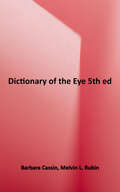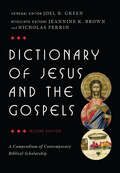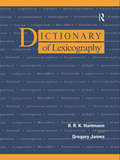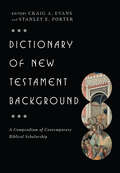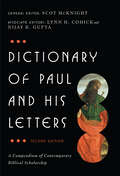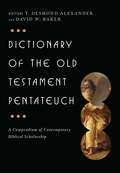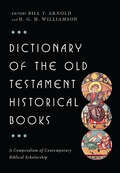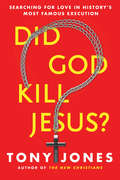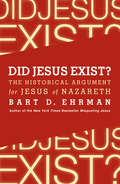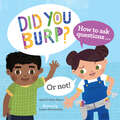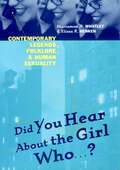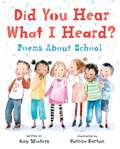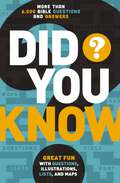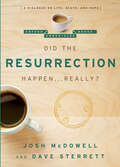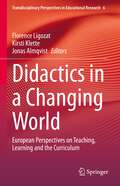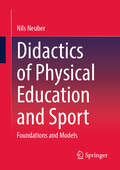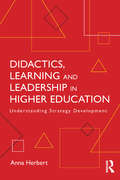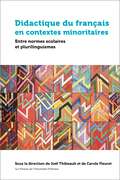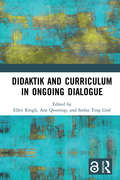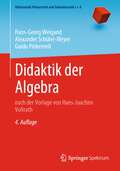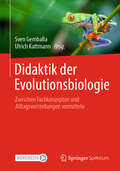- Table View
- List View
Dictionary of Eye Terminology
by Barbara CassinPocket-sized dictionary of ophthalmic terminology, for ophthalmology residents, optometry students, and medical students. Features coverage of acronyms, synonyms, commonly misspelled words, and pronunciation. Extensively cross-referenced. Previous edition: c1996. Wire-spiral bound. DNLM: Ophthalmology--dictionaries.
Dictionary of Jesus and the Gospels (The IVP Bible Dictionary Series)
by Joel B. Green Nicholas Perrin Jeannine K. BrownChristianity TodayPreaching'sDictionary of Jesus and the GospelsDJGDictionary of Jesus and the GospelsDictionary of Jesus and the Gospels
Dictionary of Lexicography
by R. R. Hartmann Gregory JamesDictionaries are among the most frequently consulted books, yet we know remarkably little about them. Who makes them? Where do they come from? What do they offer? How can we evaluate them?The Dictionary of Lexicography provides answers to all these questions and addresses a wide range of issues:* the traditions of dictionary-making* the different types of dictionaries and other reference works (such as thesaurus, encyclopedia, atlas and telephone directory)* the principles and concerns of lexicographers and other reference professionals* the standards of dictionary criticism and dictionary use.It is both a professional handbook and an easy-to-use reference work.This is the first time that the subject has been covered in such a comprehensive manner in the form of a reference book. All articles are self-contained, cross-referenced and uniformly structured. The whole is an up-to-date and forward-looking survey of lexicography.
Dictionary of New Testament Background: A Compendium of Contemporary Biblical Scholarship (The IVP Bible Dictionary Series)
by Craig A. Evans Stanley E. PorterDictionary of New Testament BackgroundDictionary of Jesus and the Gospels, the Dictionary of Paul and His LettersDictionary of the Later New Testament and Its DevelopmentsDictionary of New Testament BackgroundDictionaryDictionary of New Testament Background
Dictionary of Newfoundland English
by W. J. Kirwin G. M. Story J.D.A. WiddowsonThe Dictionary of Newfoundland English, first published in 1982 to regional, national and international acclaim, is a historical dictionary that gives the pronunciations and definitions for words that the editors have called "Newfoundland English". The varieties of English spoken in Newfoundland date back four centuries, mainly to the early seventeenth century migratory English fishermen of Cornwall, Devon, Dorset and Somerset, and to the seventeenth to the nineteenth century immigrants chiefly from south-eastern Ireland. Culled from a vast reading of books, newspapers and magazines, this book is the most sustained reading ever undertaken of the written words of this province. The dictionary gives not only the meaning of words, but also presents each word with its variant spellings. Moreover, each definition is succeeded by an all-important quotation of usage which illustrates the typical context in which word is used. This well-researched, impressive work of scholarship illustrates how words and phrases have evolved and are used in everyday speech and writing in a specific geographical area. The Dictionary of Newfoundland English is one of the most important, comprehensive and thorough works dealing with Newfoundland. Its publication, a great addition to Newfoundlandia, Canadiana and lexicography, provides more than a regional lexicon. In fact, this entertaining and delightful book presents a panoramic view of the social, cultural and natural history, as well as the geography and economics, of the quintessential lifestyle of one of Canada's oldest European-settled areas. This second edition contains a Supplement offering approximately 1500 new or expanded entries, an increase of more than 30 per cent over the first edition. Besides new words, the Supplement includes modified and additional senses of old words and fresh derivations and usages.
Dictionary of Paul and His Letters: A Compendium of Contemporary Biblical Scholarship (The IVP Bible Dictionary Series)
by Lynn H. Cohick Scot McKnight Nijay K. GuptaThe Dictionary of Paul and His Letters is a one-of-a-kind reference work. No other resource presents as much information focused exclusively on Pauline theology, literature, background, and scholarship. This second edition is a thoroughly revised and updated version of the acclaimed 1993 publication. Since that groundbreaking volume was published, developments in Pauline studies have continued at a rapid pace, with diverse new scholars entering the conversation, new ideas and methods gaining attention, and fresh expressions of old topics shaping the present discussion. Those who enjoyed and benefited from the wealth in the first edition will find this new edition an equally indispensable and freshly up-to-date companion to study and research. Classic topics such as Christology, justification, hermeneutics, and book studies of individual epistles receive careful treatment by specialists in the field. Topics new to this edition—including Paul and politics, patronage, and interpretations from various historical and cultural perspectives—expand the volume's breadth and usefulness. Over 95% of the articles have been written specifically for this edition. This work bridges the gap between scholars and pastors, teachers and students, and all interested readers who want a thorough treatment of key topics in a summary format. In curating and compiling these articles, the editors have sought to make them comprehensive, accessible, and useful for those pursuing further research on particular subjects. Each article's bibliography, in addition, will serve a new generation of readers for years to come. The updated Dictionary of Paul and His Letters takes its place alongside the Dictionary of Jesus and the Gospels, 2nd ed., and the other volumes in the IVP Bible Dictionary Series as a unique presentation of the fruit of biblical studies—committed to Scripture, using the best of critical methods, and maintaining dialogue with both contemporary scholarship and the challenges facing the church. The reference volumes in the series provide in-depth treatment of biblical and theological topics in an accessible encyclopedia format, including cross-sectional themes, methods of interpretation, significant historical or cultural background, and each Old and New Testament book as a whole.
Dictionary of the Old Testament: A Compendium of Contemporary Biblical Scholarship (The IVP Bible Dictionary Series)
by T. Desmond AlexanderA 2003 LOGOS Book Award WinnerAn ECPA 2003 Gold Medallion Finalist The first five books of the Old Testament lay the foundation on which the rest of Scripture stands. Its great themes, epochal events and towering figures set down vectors on which the biblical story is played out. The very shape of the rest of the Old Testament would collapse were the Penteteuch to be removed. The structure of New Testament thought would be barely intelligible without it. Here we meet the great ancestral figures of Israel--Abraham, Isaac and Jacob--and the towering figure of Moses, whose presence dominates four of these five books. The creative act of God, the paradisal garden, the exile of Adam and Eve, the judgment of the great flood, the call of Abraham from among the nations, the covenant of Abraham, the exodus from Egypt, the giving of the law at Sinai, the plan of the tabernacle, the varied experiences of Israel in the wilderness, and the announcement of the covenant blessings and curses--all of these and more contribute to a work of world-formative power. This dictionary explores the major themes and contours of the Pentateuch. Behind and beneath the grandeur of the Pentateuch, issues of historicity have both puzzled and beckoned. But whereas in the mid-twentieth century many English-speaking scholars were confident of archaeological support for the patriarchal accounts, the climate has now changed. In the most extreme cases, some contemporary scholars have radically challenged the antiquity of the ancestral stories, arguing for their final composition even as late as the Hellenistic era. This dictionary examines and weighs the historical issues and poses possible solutions. The documentary hypothesis, the former reigning critical consensus, is now widely rumored to be on life support with no heir apparent. Meanwhile, conservative scholars reconsider what indeed a claim to Mosaic authorship should entail. This dictionary offers an assessment of the array of questions surrounding these issues and considers some possible ways forward for evangelical scholarship. At the same time, there has been a fruitful turning to the nature, message and art of the received text of the Pentateuch. Literary studies of brief episodes, sprawling sagas, complex narrative and even the fivefold composition of the Pentateuch itself have delivered promising and exciting results. This dictionary offers both appreciative panoramas and close-up assessments of these developments and their methods. The Dictionary of the Old Testament: Pentateuch is the first in a four-volume series covering the text of the Old Testament. Following in the tradition of the four award-winning IVP dictionaries focused on the New Testament and its background, this encyclopedic work is characterized by close attention to the text of the Old Testament and the ongoing conversation of contemporary scholarship. In exploring the major themes and issues of the Pentateuch, editors T. Desmond Alexander and David W.Baker, with an international and expert group of scholars, inform and challenge through authoritative overviews, detailed examinations and new insights from the world of the ancient Near East. The Dictionary of the Old Testament: Pentateuch is designed to be your first stop in the study and research of the Pentateuch, on which the rest of the Bible is built. Note: Because this ebook is large, please allow a little extra time to download after purchase.
Dictionary of the Old Testament: Historical Books (The IVP Bible Dictionary Series)
by Bill T. ArnoldDictionary of the Old Testament: Historical BooksDictionary of the Old Testament: PentateuchDictionary of the Old Testament: Historical BooksDOTHB.DOTHBDOTHBDOTHB
Dictionary of the Old Testament: Prophets (The IVP Bible Dictionary Series)
by Mark J. Boda2013 ECPA Book Award finalistDictionary of the Old Testament: Prophets
Did God Kill Jesus?: Searching for Love in History's Most Famous Execution
by Tony JonesThe theologian and author of The God of Wild Places dispels the angry God narrative of crucifixion in this uplifting and accessible book.Many Christians believe that God the Father demanded his only Son die a cruel, gruesome death to appease His wrath, since humanity is so irredeemably sinful and therefore repugnant to God. Tony Jones, popular progressive Christian blogger, author, and scholar, argues that this understanding is actually a medieval invention and not what the Bible really teaches. In Did God Kill Jesus?, Jones looks beyond medieval convictions to reframe how we see Jesus's death. Christians today must transcend the shame and guilt that have shaped conceptions of the human soul and made us fearful of God, and replace them with love, grace, and joyfulness, which better expresses what the cross is really about.How we understand the cross reflects directly what kind of God we worship. By letting go of the wrathful God who cannot stand to be in our presence unless he pretends to see Jesus in our place, we discover the biblical God who reaches out to love and embrace us while "we were yet sinners." Jones offers a positive, loving, inclusive interpretation of the faith that is both challenging and inspiring.
Did Jesus Exist?
by Bart D. EhrmanFor years Bart Ehrman has been routinely bombarded with one question: Did Jesus Exist? As a leading Bible expert, fans and critics alike have sent letters, emails, posted blogs, and questioned Ehrman during interviews wanting his opinion about this nagging question that has become a conspiracy theorist cottage industry the world over. The idea that the character of Jesus was an invention of the early church-and later a tool of control employed by the Roman Catholic Church-is a widely held belief and Ehrman has decided it's time to put the issue to rest. Yes, the historical Jesus of Nazareth did exist. Known as a master explainer with deep knowledge of the field, Ehrman methodically demolishes both the scholarly and popular "mythicist" arguments against the existence of Jesus. Marshaling evidence from within the Bible and the wider historical record of the ancient world, Ehrman tackles the key issues that surround the popular mythologies associated with Jesus and the early Christian movement. Throughout Did Jesus Exist? Ehrman establishes the criterion for any genuine historical investigation and provides a robust defense of the methods required to discover the Jesus of history. Those committed to the "non-existence" theory will need to read this formidable scholar's counter argument while the more traditionally minded will enthusiastically support Ehrman's definitive answer to the question. Perfect for the vigorous online debating community, this eBook original will be a must read for anyone interested in Jesus, the Bible, and the birth of Christianity.
Did You Burp?: How to Ask Questions (or Not!)
by April Pulley SayreAsking questions may seem like it comes naturally, but it's actually a learned social skill. How do questions and answers work? What makes a good question--and what makes a rude one? Who cares about questions?This helpful how-to guide teaches kids what a question is, when to ask one, and how to form one. Friendly tips and pointers ("Keep it short!" "Show interest!") help kids keep their questions appropriate and on point. Above all, the book encourages readers to keep on asking questions--the beginning of learning about the world.
Did You Hear About The Girl Who . . . ?: Contemporary Legends, Folklore, and Human Sexuality
by Marianne H Whatley Elissa R Henken&“Takes the reality of boys and girls seriously, while never flinching from providing the best health information available.&” —Gary Alan Fine, Northwestern University, author of Manufacturing Tales: Sex and Money in Contemporary Legends Ever hear the one about the man who wakes up after a chance sexual encounter to discover he's been involuntarily relieved of one of his kidneys? Everyone knows contemporary legends, those lurid, cautionary tales, always told as though they happened to the friend of a friend. Sometimes we pass them on to others unsure of their truthfulness, usually we dismiss them as urban legends. But these stories tell us a lot about our deepest fears and fantasies. In fact, a large part of what we know about our bodies we have learned from kids on the playground or colleagues at work, from information contained in folk beliefs, jokes and legends. Sexual folklore goes beyond classroom lessons of mechanics to answer many questions about what people actually do and how they do it. Mariamne H. Whatley and Elissa R. Henken have collected hundreds of sexually-themed stories from college students in order to tell us what they reveal about our sexual attitudes. They confront myths and stereotypes about sexual behavior and use folklore as a tool to educate students about sexual health and gender relations, presenting these tales in a way that is intriguing and educational. &“As intelligent as it is interesting and funny.&” ― Journal of Sex Research &“A must read for sexuality educators and youth workers . . . Fun, clever, engaging and provocative.&” —Michelle Fine,CUNY Graduate Center, author of Framing Dropouts: Notes on the Politics of an Urban High School
Did You Hear What I Heard?: Poems About School
by Kay WintersA joyful, poetic celebration of kindergarten and first gradePoet Kay Winters has written a book of zippy poems centering on the triumphs and trials of those first school years. This cheery collection covers an astonishing range of activities from the anticipated--dashing to the bus and science class discoveries--to the completely unexpected--losing a permission slip and seeing a teacher outside the classroom. Patrice Barton's sweetly smudgy watercolor illustrations show a wonderfully diverse class of young students, making this an ideal selection for every collection.
Did You Know?: More Than 6,000 Bible Questions and Answers
by Thomas NelsonLearning about the Bible is one of the most important things you can do. It can also be fun and exciting! Did You Know? helps you engage the Bible from beginning to end in new and interesting ways. For ease of use, questions are sorted into sections, including History, Poetry, Prophecy, Gospels, Acts of the Apostles, and Epistles. Short answer, true/false, and multiple choice questions help scholars and laypeople alike learn Bible facts with ease. Illustrations, lists, and maps are perfect tools for visual learners. Did You Know? is enjoyable for Bible enthusiasts of all ages and life-stages, and is the perfect choice for any individual or small group looking to learn Bible facts and have a little fun along the way. Features include: 6,000 Bible questions and answers teach facts in fun waysSections are easy to navigateBackground information provides a deeper understanding of biblical factsIllustrations, lists, and maps engage visual learners
Did the Resurrection Happen . . . Really?: A Dialogue on Life, Death, and Hope (The Coffee House Chronicles)
by Dave Sterrett Josh McDowellWith over 40 million books sold, bestselling author Josh McDowell is no stranger to creatively presenting biblical truth. Now, partnering with fellow apologist Dave Sterrett, Josh introduces a new series targeted at the intersection of story and truth.The Coffee House Chronicles are short, easily devoured novellas aimed at answering prevalent spiritual questions. Each book in the series tackles a long-contested question of the faith, and then answer these questions with truth through relationships and dialogue in each story.In Did the Resurrection Happen, Really?: A Dialogue on Life, Death, and Hope, the college campus is rocked by a shooting spree that leaves nine students dead. Their up-close experience with mortality allies the coffee house discussion group together to really wrestle with the spiritual and eternal ramifications of whether or not Jesus rose from the dead.The other two books in the series: Is the Bible True, Really? and Who is Jesus, Really? continue the unfolding story at the college campus and the coffee house down the road.
Did the Resurrection Happen . . . Really?: A Dialogue on Life, Death, and Hope (The Coffee House Chronicles)
by Dave Sterrett Josh McDowellWith over 40 million books sold, bestselling author Josh McDowell is no stranger to creatively presenting biblical truth. Now, partnering with fellow apologist Dave Sterrett, Josh introduces a new series targeted at the intersection of story and truth.The Coffee House Chronicles are short, easily devoured novellas aimed at answering prevalent spiritual questions. Each book in the series tackles a long-contested question of the faith, and then answer these questions with truth through relationships and dialogue in each story.In Did the Resurrection Happen, Really?: A Dialogue on Life, Death, and Hope, the college campus is rocked by a shooting spree that leaves nine students dead. Their up-close experience with mortality allies the coffee house discussion group together to really wrestle with the spiritual and eternal ramifications of whether or not Jesus rose from the dead.The other two books in the series: Is the Bible True, Really? and Who is Jesus, Really? continue the unfolding story at the college campus and the coffee house down the road.
Didactics in a Changing World: European Perspectives on Teaching, Learning and the Curriculum (Transdisciplinary Perspectives in Educational Research #6)
by Kirsti Klette Florence Ligozat Jonas AlmqvistThe collection of chapters in this book results from ongoing scientific discussions on teaching, learning and curriculum studies in Europe. Didactics as a research field and area of knowledge deals with questions about teaching, learning and educational content. Didactics explores institutionalized teaching and learning processes that are fundamental to allow people living together and acting as citizens. It connects curriculum issues to classroom practices and student’s learning experience in a unique manner that goes beyond the field of curriculum studies and the field of the learning sciences. Focusing on different research traditions for conceptualizing the relationships between learning and teaching through the educational content learnt, the book presents advanced research in field of “Didactics - teaching and learning” that addresses the new challenges faced by the teaching profession.The collection of chapters in this book supports the continuous growth of comparative research on classroom practices and addresses in a novel manner the need for including international perspectives on Didactics in teacher education programs and graduate schools in education worldwide.Part 1 highlights the recent advances in the theoretical development of Didactics and more particularly the development of comparative didactics. Part 2 illustrates the diversity and complementarities of theoretical and methodological approaches for the empirical study of classroom practices. Part 3 maps certain societal challenges that didactic research faces in a changing world.
Didactics of Physical Education and Sport: Foundations and Models
by Nils NeuberThe volume provides an overview of subject didactic foundations and models in sports. Starting with socio-cultural contexts and educational foundations of movement, play, and sports offerings for children and adolescents, sport didactic models and concepts are introduced. This is followed by considerations on methods in physical education as well as individualized support in sports as an integrative concept. Overall, the textbook focuses on the general prerequisites for physical education.
Didactics of Smart Pedagogy: Smart Pedagogy for Technology Enhanced Learning
by Linda DanielaThe focus on smart education has become a new trend in the global educational field. Some countries have already developed smart education systems and there is increasing pressure coming from business and tech communities to continue this development. Simultaneously, there are only fragmented studies on the didactic aspects of technology usage. Thus, pedagogy as a science must engage in a new research direction—smart pedagogy. This book seeks to engage in a new research direction, that of smart pedagogy. It launches discussions on how to use all sorts of smart education solutions in the context of existing learning theories and on how to apply innovative solutions in order to reduce the marginalization of groups in educational contexts. It also explores transformations of pedagogical science, the role of the educator, applicable teaching methods, learning outcomes, and research and assessment of acquired knowledge in an effort to make the smart education process meaningful to a wide audience of international educators, researchers, and administrators working within and tangential to TEL.
Didactics, Learning and Leadership in Higher Education: Understanding Strategy Development
by Anna HerbertDidactics, Learning and Leadership in Higher Education presents a new model for understanding development strategies for learning and leadership. It describes a shift in perspectives on teaching practices and develops concepts which facilitate a new discourse, placing learning and teaching strategies on the agenda and ensuring the development of good leadership practices inherent to teaching. By applying Lacanian discourses to Klafki’s triangle in relation to learning strategies, this innovative new text aids discussion of the diff erences between terms such as ‘performance’ and ‘performativity’, ‘acting’ and ‘actorship’ to enable teaching staff to utilise practical applications and teach most eff ectively. It examines key points such as the likely outcomes of specifi c leadership strategies and how they can be adapted, thus creating an essential dialogue between students and teachers. Combining research in the fi elds of philosophy, psychology, economics, geography and sociology describing a change in relation to use of time, space and management of matter, Didactics, Learning and Leadership in Higher Education is a key text for all those involved in teaching within higher education.
Didactique du français en contextes minoritaires: Entre normes scolaires et plurilinguismes (Éducation)
by Joël Thibeault et Carole FleuretDans Didactique du français en contextes minoritaires, des chercheurs établissent des ancrages théoriques en sociologie, en linguistique, en psychologie cognitive et en éducation, pour faire état de la recherche et de la théorie sur la didactique du français en contextes francophones minoritaires. Au fil des chapitres, les auteurs mettent en évidence la nécessité d’un enseignement du français qui soit signifiant et qui, en ce sens, soit pensé en fonction des caractéristiques qui sont propres aux populations scolaires qui évoluent dans les contextes francophones minoritaires du Canada. Dans cet ouvrage privilégiant une approche humaniste, les auteurs posent les jalons d’une didactique du français qui, afin de permettre aux apprenants de s’approprier les normes scolaires qui favoriseront leur épanouissement en société, s’inspire de leurs réalités, de leurs trajectoires, de leurs histoires, de leurs forces et des défis qu’ils rencontrent.
Didaktik and Curriculum in Ongoing Dialogue
by Ellen Krogh; Ane Qvortrup; Stefan Ting GrafDidaktik and Curriculum in Ongoing Dialogue revives the dialogue between the continental European Didaktik tradition and the Anglo-Saxon tradition of curriculum. It highlights important research findings that bridge cultural differences and argues for a mutual exchange and understanding of ideas. Through analyses of shared conditions and cultural differences, the book invites a critical stance and continued dialogue on issues of significant importance for the current and future education of children and young people. It combines research at empirical, conceptual, and theoretical levels to shed light on the similarities between the Didaktik and Anglo-Saxon educational traditions, calling for a comprehensive understanding of teaching and a renewed focus on content and knowledge. Addressing theoretical issues within contemporary educational scholarship, the book will be of great interest to academics, researchers, and post-graduate students in the fields of curriculum studies, education theory, and comparative education.
Didaktik der Algebra: nach der Vorlage von Hans-Joachim Vollrath (Mathematik Primarstufe und Sekundarstufe I + II)
by Hans-Georg Weigand Guido Pinkernell Alexander Schüler-Meyer(Autor) Hans J. Vollrath / Hans - Georg Weigand (Titel) Algebra in der Sekundarstufe (HL) Jetzt mit über 120 neuen Aufgaben (copy) Dieses Buch behandelt ausführlich die klassischen Themenstränge, die den Algebraunterricht durchziehen: - Zahlen - Terme - Funktionen - Gleichungen Für diese Themen werden ihre historischen Wurzeln, didaktisch relevante mathematische Grundlagen, Lernmodelle und Unterrichtsvorschläge dargestellt. Dabei wird auch auf typische Lernschwierigkeiten und ihre Überwindung eingegangen. Das Buch liegt nun in der vollständig überarbeiteten dritten Auflage von jetzt zwei Verfassern vor. Mit zahlreichen Hinweisen und Beispielen für den Einsatz des Taschenrechners und des Computers werden Anregungen zu einer Neugestaltung des Algebraunterrichts gegeben. (Biblio)
Didaktik der Evolutionsbiologie: Zwischen Fachkonzepten und Alltagsvorstellungen vermitteln
by Sven Gemballa Ulrich KattmannDieses Buch trägt der enormen Bedeutung der Evolutionstheorie als Bestandteil einer aufgeklärten Bildung und eines modernen Selbst‐ und Weltverständnisses Rechnung. Die Evolutionstheorie zählt zu den bedeutendsten naturwissenschaftlichen Theorien, wurde aber wie kaum eine andere Theorie kontrovers diskutiert und ideologisch missbraucht. Eine wirksame Vermittlung der Evolutionstheorie muss dieser enormen Bedeutung und den Voraussetzungen der Lernenden gerecht werden. Expertinnen und Experten aus der fachwissenschaftlichen und fachdidaktischen Forschung sowie der Unterrichtspraxis stellen in 31 Beiträgen Fachkonzepte zur Evolutionstheorie und lebensweltliche Vorstellungen von Lernenden dar, die dann nach dem Modell der „Didaktischen Rekonstruktion“ aufeinander bezogen werden. Bei dieser didaktischen Strukturierung werden lebensweltliche Vorstellungen von Lernenden als Lernchance genutzt, um davon ausgehend fachlich angemessene Konzepte zu vermitteln. Die Beiträge berücksichtigen die Teilgebiete der Evolutionstheorie sowie die Besonderheiten verschiedener Schulstufen, die Kontroversen um die Evolutionstheorie und außerschulische Lernorte. Sie richten sich an Forschende aus der Fachdidaktik ebenso wie an Lehrpersonal in Schule, Hochschule und Lehrkräfteausbildung.
